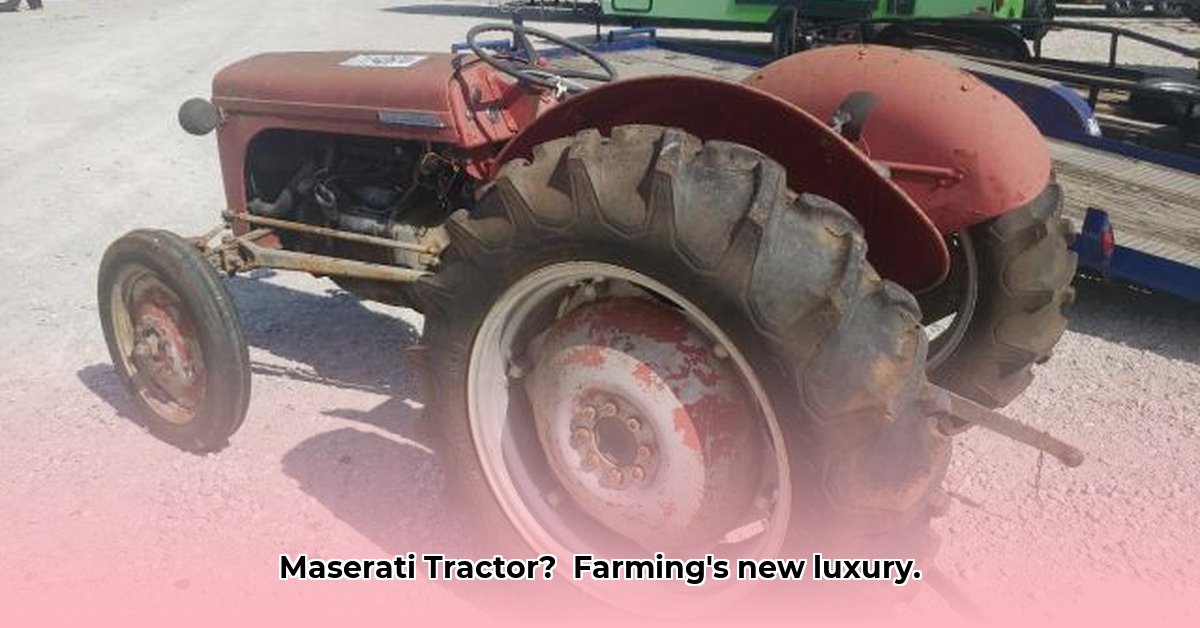
A Splash of Blue in the Fields: More Than Just a Pretty Tractor
New Holland's limited-edition T7000 series tractors, a striking Maserati blue, represent a bold disruption in the agricultural world. This isn't just about aesthetics; it's a high-end statement in a traditionally budget-conscious industry. But is this luxury approach purely a marketing ploy, or does it offer tangible benefits? This case study examines the implications of this premium tractor, exploring its technical features, market viability, and environmental considerations.
Under the Hood (and the Leather Seats): High-Tech and High-Touch
Beyond the eye-catching paint job, these tractors boast significant technological advancements. The high-performance Trelleborg tires, for instance, offer superior grip, reducing soil compaction and potentially maximizing crop yields. Inside, the IntelliView III monitor and SideWinder II armrest simplify machine operation. Luxury features like plush leather seats and advanced suspension enhance operator comfort. But does this level of luxury translate into practical, cost-effective farming? A cost-benefit analysis is crucial to determine the return on investment for these premium features.
The Price of Prestige: A Calculated Risk?
These tractors command a significantly higher price than standard T7000 models. This premium pricing targets a niche market: wealthy landowners, large agricultural businesses, and those prioritizing exceptional comfort and advanced technology. The long-term success hinges on sufficient market demand and whether this premium model serves as a springboard for technological advancements that eventually trickle down to more affordable models. Will the high initial investment justify itself through increased efficiency and productivity?
The Environmental Angle: Luxury and Sustainability – Can They Coexist?
Assessing the environmental impact of these luxury tractors is paramount. While increased efficiency might lead to decreased fuel consumption and emissions over the tractor's life, the manufacturing process itself presents environmental concerns. The production of some materials, such as certain chrome accents, can have a substantial environmental footprint. A comprehensive lifecycle assessment (LCA) is urgently needed to quantify the total environmental impact, comparing it with standard models. Only then can we determine if the efficiency gains outweigh the environmental costs of production. "Further advancements in sustainable material production hold promise for reducing the environmental impact," says Dr. Anya Sharma, Environmental Scientist at the University of California, Berkeley.
A Closer Look at the Numbers: What the Data Suggests
To fully understand the impact, comprehensive data is needed. Independent testing is required to verify claims regarding fuel efficiency, soil compaction, and the long-term reliability of premium components. A detailed cost comparison, including maintenance, fuel consumption, and resale value, is essential. How does the increased initial cost compare to potential savings in fuel consumption and labor costs over the tractor's lifecycle? Will the enhanced comfort lead to reduced operator fatigue and increased productivity? This rigorous analysis is crucial before drawing definitive conclusions about cost-effectiveness.
| Feature | Maserati Tractor (Estimated) | Standard T7000 (Estimated) | Notes |
|---|---|---|---|
| Initial Purchase Price | Significantly Higher | Significantly Lower | Premium features justify higher cost; comprehensive ROI analysis is crucial. |
| Fuel Efficiency | Potentially Higher | Potentially Lower | Requires independent verification through rigorous testing. |
| Maintenance Costs | Potentially Higher | Potentially Lower | Premium components may require specialized maintenance, but could offer increased longevity. |
| Resale Value | Potentially Higher | Potentially Lower | Brand prestige and limited availability could influence resale value. |
| Environmental Impact | Potentially Higher (initially) | Potentially Lower (initially) | LCA needed to determine if long-term emissions are lower due to increased efficiency. |
How to Assess the Environmental Impact of Luxury Tractor Production
This section focuses on the methodology for evaluating the environmental impact, a critical aspect often overlooked in discussions of luxury goods. The high initial cost and premium materials necessitate a thorough examination of the entire production and operational lifecycle.
Deconstructing the Environmental Footprint: A Step-by-Step Approach
A comprehensive assessment requires a lifecycle analysis (LCA) approach, meticulously examining each stage:
- Raw Material Sourcing: Evaluating the carbon footprint and sustainability of sourcing premium materials. Are these materials sustainably harvested and processed?
- Manufacturing Process: Assessing the energy intensity and waste generation during manufacturing. What specific technologies are used and what is their environmental impact?
- Transportation and Logistics: Quantifying the greenhouse gas emissions associated with transporting the tractor from the factory to the farm.
- Operational Use: Measuring fuel efficiency and emissions during the tractor's operational lifetime. Comparing this data to that of standard models is essential to determine any environmental benefit.
- End-of-Life Management: Determining the recyclability of components and the methods used for responsible disposal. Does the manufacturer have a clear plan for end-of-life management?
Comparative Analysis: Luxury vs. Standard
A direct comparison with standard T7000 models is crucial. This comparative analysis should include energy consumption, emissions, waste generation, and the overall environmental footprint across the entire product lifecycle.
Transparency and Data Disclosure: Essential for Informed Decisions
Manufacturers must prioritize data transparency. Openly sharing information on material sourcing, manufacturing processes, and operational performance helps consumers make informed decisions and promotes responsible innovation.
The Future of Farming: A New Paradigm?
New Holland's foray into luxury tractors is a bold gamble, testing the boundaries of the agricultural machinery market. Whether this premiumization redefines farming or remains a niche market remains to be seen. However, the technological advancements incorporated into these high-end models may eventually influence the design and capabilities of future, more affordable models. The ultimate success of this approach fundamentally depends on the broader adoption of the technology. “This is a fascinating case study in balancing luxury with sustainability, and the data obtained will impact future tractor design,” notes Mr. David Miller, Head of Agricultural Engineering at Purdue University.